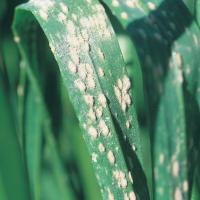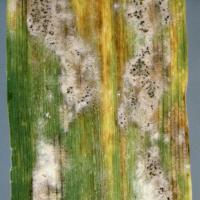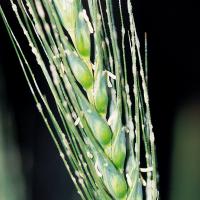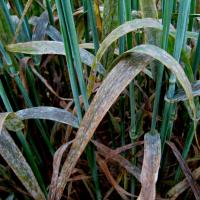Diagnosing powdery mildew in cereals
Powdery mildew is a fungal leaf disease that reduces yield and grain quality in susceptible varieties. Different species of powdery mildew infect barley and wheat but control methods are the same.
What to look for
- Yellowing leaves visible in canopy.
Paddock
- Fluffy, white powdery growths of fungal spores on leaf surface.
- Fluffy, white powdery growth affecting stems and heads under severe disease pressure.
- Fungal colonies eventually enlarge and coalesce.
- The area surrounding the lesion and on the reverse side of the leaf turns yellow to brown.
- Older infections turn grey and can develop black fruiting bodies.
- Moderate to severe infections can result in leaf death.
Plant
Where did it come from?
- The fungus survives as fruiting bodies on stubbles that release spores after autumn rains. Spores can spread over long distances.
- White powdery leaf infection release more wind-spread spores.
- Spore production and infection is greatest at 15 to 22°C and is retarded at temperatures above 25°C.
- Humid conditions and dense crop canopies favour the disease.
- Mildew often disappears rapidly in the higher temperatures and lower relative humidity of the spring months.
Management strategies

Resistant varieties

Seed dressing fungicide

Rotation

Spraying foliar

- Wheat is less likely to have levels of powdery mildew infection needing treatment than barley. Use resistant barley varieties if available.
- Fungicide seed dressings or in-furrow fungicides with foliar activity give important protection to young barley crops (up to eight weeks).
- Foliar fungicides can be used to control powdery mildew infection, application early in disease development is most effective.
- Crop rotation and stubble management are generally ineffective in controlling the disease.
- Resistance to some triazole fungicides in barley powdery mildew. If you suspect fungicide resistance is occurring, samples can be submitted for testing to the Fungicide Resistance Group at the Centre for Crop and Disease Management, Curtin University, Perth. Phone 08 9266 1204 or email frg@curtin.edu.au for a sample kit.
Economic and financial considerations
To assist in assessing the economic risk and financial costs associated with various treatment strategies go to MyEconomicTool
There may be other economic and financial implications that need to be considered when choosing a management option. These may include:
Pre-crop- Assess the risk of powdery mildew occurring.
- Assess the costs and benefits of taking preventative action.
- Compare the costs, benefits and risk of each management option against doing nothing.
- Ignore all previous treatment costs in assessing current management options.
- Use integrated disease management to reduce disease pressure and reliance on fungicides.
View these economic considerations in more detail.
See also
Further information
Page last updated: Wednesday, 11 November 2015 - 9:13am





